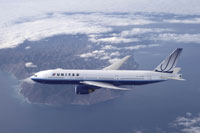
UNITED Airlines has announced plans to offer three weekly flights from Kuwait City to Washington DC from late October, adding the Middle East region to its strong global network.
United will be the only US airline to offer non-stop service between Kuwait and the United States. Customers will be able to make reservations as of early June and launch fares are expected to be in the region of $1300.
“Launching service to Kuwait further demonstrates our commitment to expanding our global network, bringing our passenger and cargo customers closer to the world's key economic centres,” said John Tague, United’s executive vice president and chief revenue officer. “Our business and cargo customers will soon have direct access into the Middle East where there is strong demand from the petroleum, energy and shipping industries.”
United plans to operate a combined passenger and cargo service between Kuwait and US using a Boeing-777 aircraft in a three-class configuration.
The new route is no surprise, what with Emirates, Qatar Airways and Etihad already flying to the States. Says Marcel Fuchs, managing director Sales, Europe, Africa, Middle East and India, “If you look at 2005, last year was the year of shifting from the domestic to the international. We are now going into China, Australia, Japan, Vietnam, growing 15-16 per cent in the Pacific last year,” he told TTN at ATM.
The company has been seeing double-digit growth out of the Middle East every year, says Fuchs. “The first quarter has also been extremely encouraging – a market like Saudi Arabia, surprisingly, is emerging as a strong market post 9/11. We are very pleased with that, we enjoy a very very solid revenue growth from the Middle East.”
For customers choosing to fly out of other cities in the region, Fuchs points to the Star Alliance network, which links over Europe with Lufthansa, Swiss, Austrian Airlines and bmi. “We also very actively connect over London with some of the regional carriers like Emirates and Qatar Airways, who we work very closely with, a relationship we hope to develop further in the next couple of months,” he says. United operates 26 daily Trans-Atlantic flights from Europe to the US, 14 from the mainland and 12 from the UK.
As of 2005, the airline was still making losses, but Fuchs points to its restructuring over the past few years. “The United today is not the United we were four or five years ago. We are down to 57,000 employees from 105,000, but we haven’t cut out flying into half. Compared to pre 9/11 levels we are down about 20 per cent. We have enjoyed double digit growth, in terms of quality domestically and have seen a very good growth in terms of load factor. Thanks to our lowering of capacity over the last 2-3 years, our annual load factor is somewhere like 81 per cent and we have a significant revenue contribution coming from the North American franchise.” He says the company capitalizes on its strengths: 460 airplanes and the best hub network structure in the US. “Today as we stand we have really got our house in order. If you look today at the fuel price, today we have got to just make sure that we keep doing good work.”
But what does this increased efficiency mean for agents and our commissions? “I don’t want to hide behind a cosy statement, but we are always looking to improve efficiency in that respect. The distribution costs remain high, too high. In the Middle East, however, the agents are the most important distribution channel for us. I am convinced that TMCs are here to stay, they will have to evolve, like we had to evolve.”
Finally, with the Travel Industry Association of America (TIA), United is looking at solutions to simplify visa processes. “Whatever approach we can take to make this process easier we will do, but we have to still work with the ministries and immigration departments. The object is to make the process more efficient,” says Fuchs.
by Keith J Fernandez
